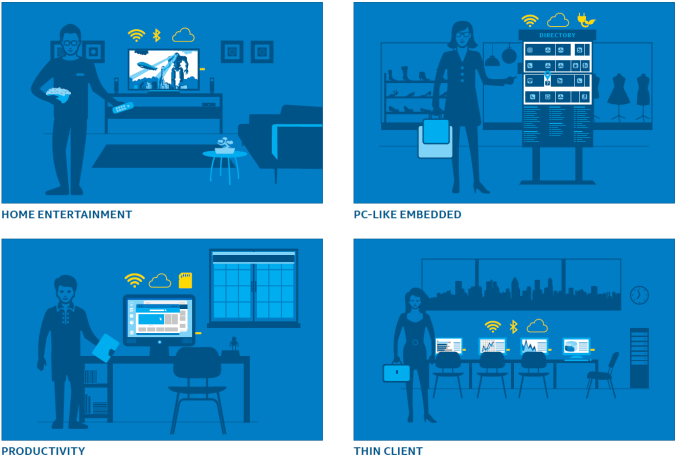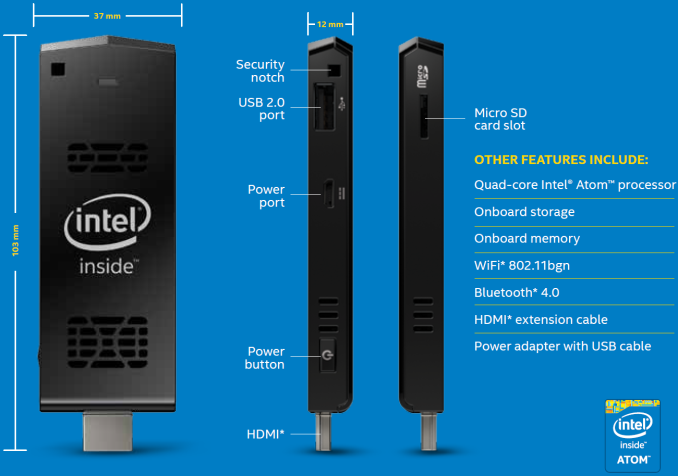Intel PPSTCK1A32WFC Bay Trail-T Compute Stick Review
by Ganesh T S on April 22, 2015 11:00 AM EST- Posted in
- Systems
- Intel
- Bay Trail
- HDMI Stick
Concluding Remarks
The Intel Compute Stick gave us the opportunity to see whether a tablet SoC could provide enough horsepower for a desktop PC. Based on our experience, the answer to that question is cautiously in the affirmative. There is no doubt that the device can do well as an economical solution for thin clients, kiosks and digital signage. These are scenarios where only one program runs for the life of the system and the OS is rarely updated.
The Compute Stick could do with some improvements for the scenarios in the left column
Traditional PCs have a different use-case compared to PC-like embedded systems and that brings us to the first problem in the Compute Stick we reviewed:
- OS drive size
32 GB, simply put, is just not enough after Windows installs a couple of updates. Out of the box, the system had around 17 GB free in the 23 GB disk (the rest, presumably, is the OS recovery partition). An initial update check resulted in a 1.3 GB download, and that installation brought down the free space to 14.3 GB. We have always been wary of Windows Updates on machines with low free space on the primary drive. As feared, attempting to install another round of updates resulted in a botched update problem (solved here). We had to spend 4+ hours getting the unit back to the initial state with a 'refresh' operation (and reinstall all the updates once again). To top it off, Windows lost activation in the refresh process and refused to reactivate (indicating a blacklisted key).
- Thermal design / solution
There is no doubt that the thermal design is very effective. Acoustic measurements come in at 28 dB at 1m distance. However, the irregular nature of the small-diameter fan makes for a strained experience if the user sits very close to the Compute Stick (possible in an office environment). It would not be a bad idea to go for a passively cooled Compute Stick at the cost of a slight increase in cost, weight and/or size.
- WLAN solution
The unit doesn't come with any wired networking facilities. It is essential that the Wi-Fi solution be top-notch. Unfortunately, a single-band 1x1 802.11n solution just doesn't cut it - particularly for scenarios involving video streaming. Thankfully, the presence of Bluetooth makes a USB keyboard / mouse unnecessary, freeing up the single USB 2.0 port for other purposes. Talking of video streaming, it would also be nice to have full HD audio support in the GPU drivers for Bay Trail-T (now that it has made its appearance in a mini-PC).
Despite the above shortcomings, the Compute Stick did impress us in a few areas - the form factor and portability aspects are praiseworthy. The CPU performance is not as bad as we feared it would be - Windows loads in a smooth manner and the system is as responsive as what one can expect from a Bay Trail-based mini-PC.
Coming to the business end of the review, we can say that the Intel Compute Stick is a typical first-generation product. In our opinion, there are way too many compromises being made to get to this form factor. There are certainly applications where the kit would be perfect, but general-purpose day-to-day computing is not one of them. If Intel wants the Compute Stick product line to take off like NUCs, addressing the three main shortcomings detailed above would be a good first step.












103 Comments
View All Comments
Deelron - Wednesday, April 22, 2015 - link
Pretty much this, plus if you're already invested in a moderate sized or greater NAS solution, it seems like it'd be pretty cost efficient to just step up to a low priced NUC anyway, unless the form factor of a large stick out the back of the TV is absolutely critical.zeo - Sunday, April 26, 2015 - link
Unless your device is using one of a few select Celeron branded Bay Trail's then it does support Quick Sync... Bay Trail uses a Gen 7 (Ivy Bridge) GPU that's just scaled down to 4EU's and slower clock for mobile usage but still supports features like Quick Sync...joex4444 - Wednesday, April 22, 2015 - link
Running a 1Gbe connection over 480Mbps USB 2.0 is inherently going to limit you. Still better than the 50Mbps or so you *might* get over the 802.11n, but really... running a CAT5 cable out to your TV is bordering on the non-trivial. Even if feasible it's not clean.nathanddrews - Thursday, April 23, 2015 - link
It's no more complicated than any other cable and is every bit as clean. I bought this http://amzn.com/B005LW4CFG a few years ago and it has made it trivial to run all my cables (HDMI, speaker wire, networking) through walls. Very feasible and clean.As for the 1GbE connection over USB 2.0 - it is slower than real GbE - but the gains in latency and throughput make it possible to stream so much more than the weak wifi permits. It's worth doing.
Hulk - Wednesday, April 22, 2015 - link
This is an interesting idea but for me there are too many limitations for me to consider it. Now at 10nm with a lower power x86 2/4 processor and 120GB of controller based storage I'd be interested as a HTPC or computer for my kids.jjj - Wednesday, April 22, 2015 - link
So a SoC that due it's perf is worth 5$ , the NAND+RAM are less than 25$, the wifi must be 3$ or less and all in all 150$ is way too much. Damn x86 monopoly.Refuge - Wednesday, April 22, 2015 - link
You can bet a lot of it is probably licensing for Windows 8.1. This isn't Windows with Bing.Lonyo - Wednesday, April 22, 2015 - link
The WIndows license is $40. The Ubuntu version is $110 vs $150 for the Windows 8.1 version.ganeshts - Wednesday, April 22, 2015 - link
Note that there is 24 GB of extra eMMC for the Win 8.1 version.BMNify - Wednesday, April 22, 2015 - link
Ubuntu version is cheaper because it has just 1GB of ram and 8GB storage, Windows 8.1 version has 2GB ram and 32GB of storage.